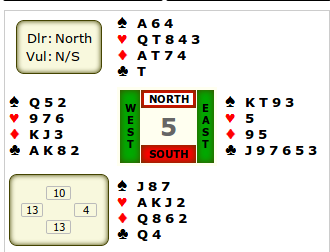This week is the annual Buchanan Congress, which has been going since at least 1967. I know it's been going since at least 1967, because 1967 is the date of the first winners who are engraved on the trophy for the Congress Pairs, which is currently sitting on my mantlepiece...
We did reasonably well in the qualifying session for the pairs, finishing something like 5th with a score of 54%, and then were run-away winners in the final with 65%. I have to admit that it really didn't feel like a 65% game, and when Horst was reading out the results, I wasn't quite sure if we'd have just sneaked ahead of the second placed pairs (Grace and James Walker and Jim McGlauchlin and Peter Cairns), who were tied on about 58% or if we'd be just behind them.
As I mentioned in my last post, I've decided that it's probably time that I learn to actively try to count a bridge hand, rather than get by on general principles and having read a lot of books, and I've been practising this with GIB, and it has made a surprising difference to the experience of playing - one of the more unexpected benefits is that I actually hope to be defending on most boards, as then I'll get to practice my counting (counting a hand as declarer is the next thing on my list of skills to acquire...). And I get to defend twice as often as I'll get to declare!
Here's one where I was glad that I had a full count on the hand - I'll go through my thought processes in tedious detail...
The auction was - - 1♦ - 1♥ - 2♥ - 4♥. This seems like pretty reasonable bidding, North liking his singleton and his holding in partner's suit. I led the ♠10. This went to the 7, 2 and Ace. So I'm pretty confident partner has the ♠Q, but not quite sure how many ♠s he has yet. Declarer drew trumps then led a ♣ to the Q. Partner cashed the ♠Q, and then played the ♣A. Declarer ruffed and exited with a ♠.
I'm now on play with two ♦s, 1♠ and 1♣ in my hand, but I know that declarer's starting shape was exactly 3-5-4-1, and he hasn't played a ♦ yet, so it's clear that I can afford to give him a ruff and discard in either of the black suits - if he has any ♦ losers then 1 ruff and discard isn't going to help him, whereas if he has the ♦J, then a ♦ might give the contract away. Now, I'd probably have played a black suit card anyway on general principles, but having a full count of the hand in this situation certainly made life easier.
Danny already blogged about this hand, where he and Anna managed to find their way into 3NT - we got 92% of the match points in the main final by playing in 2NT rather than a ♠ partial. As it happens 3NT is absolutely cast-iron (although it does require the ♠T to be in the East hand).
We weren't quite as successful in the men's teams, despite the fact that our team-mates were one of the two pairs that finished joint 2nd in the pairs... I think both of us brought back cards that would have been lucky to win even one match playing with anyone in the event, but at least we were both terrible at once. Congratulations to the team of Alasdair Forbes, Bill Durning, Ian McClure and Raymond McShane, who won that event.



On the first hand we were also in 4H, played by South after Anna opened 1NT. It went one off, as I feel it must do, although looking at the results again one table did make ten tricks. How is that possible?
ReplyDeleteOn the second hand 2NT is a clear underbid!